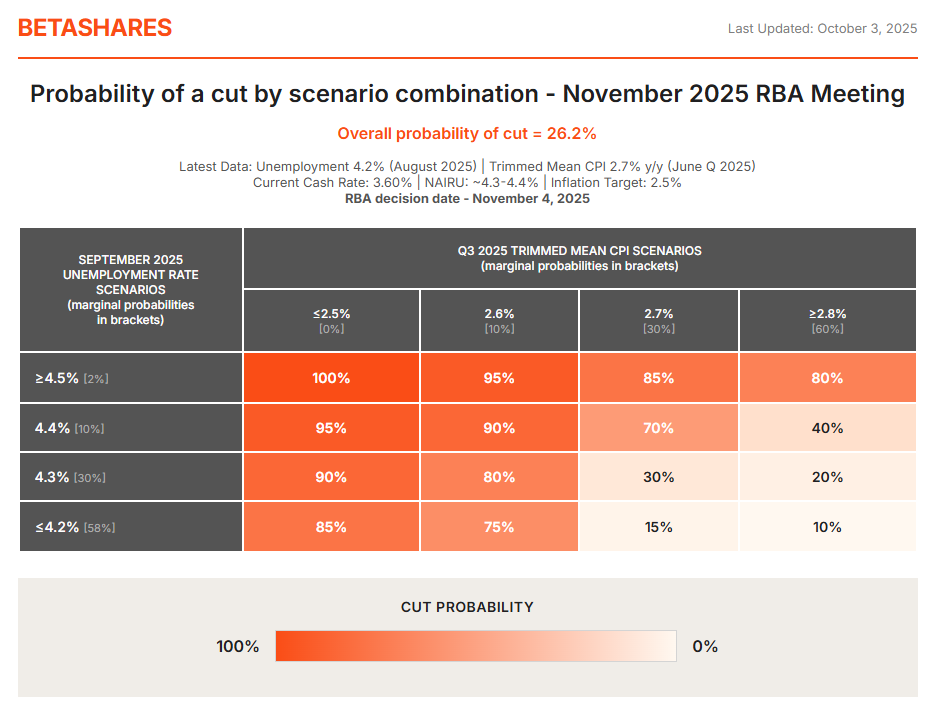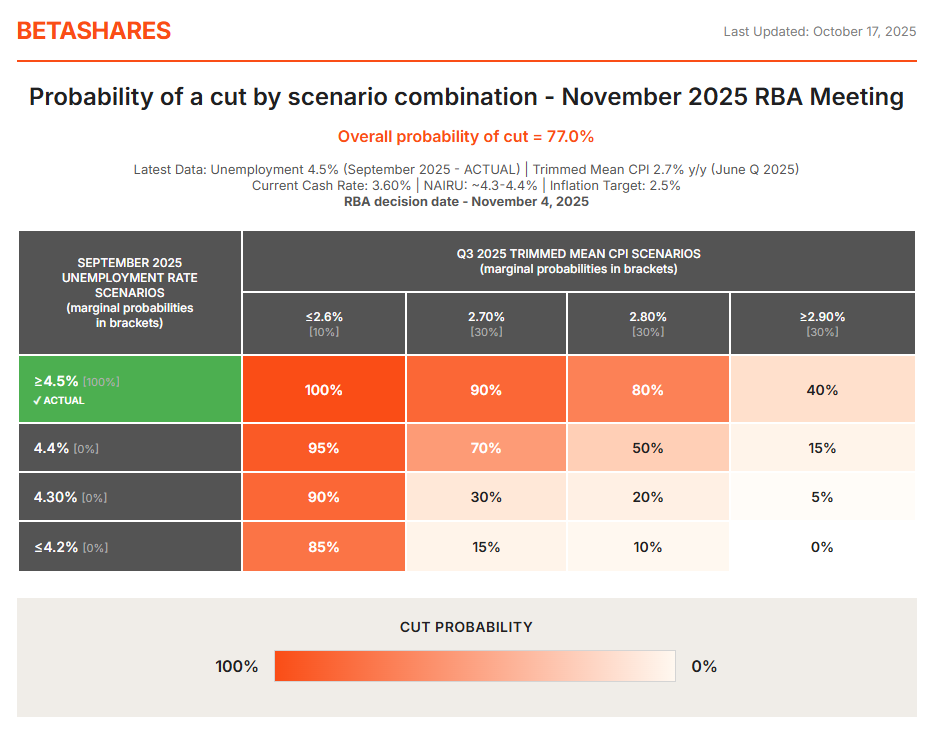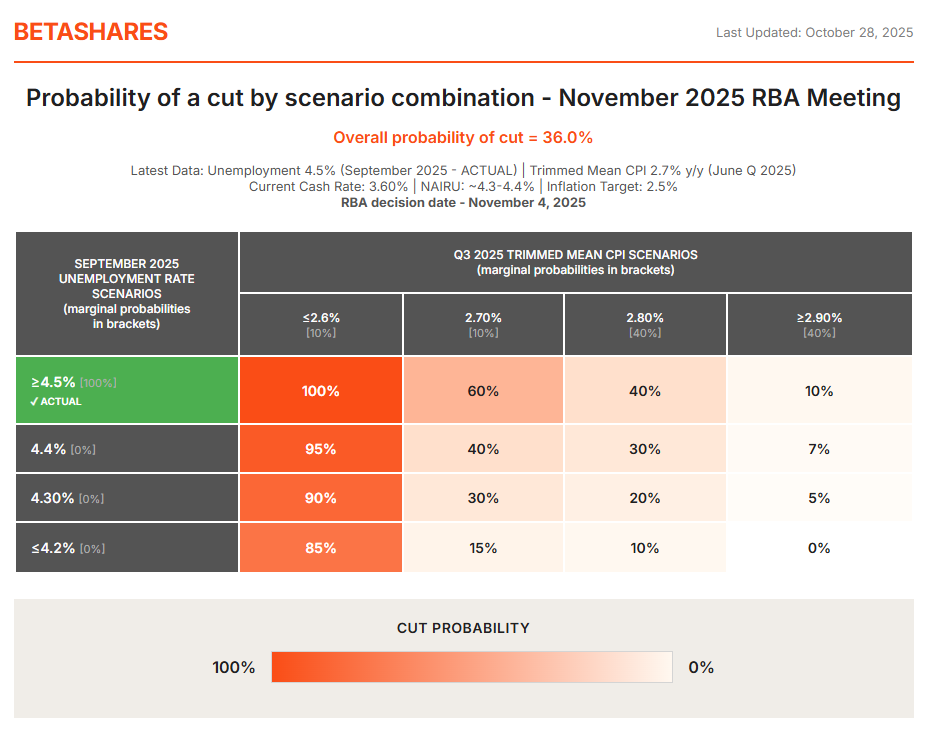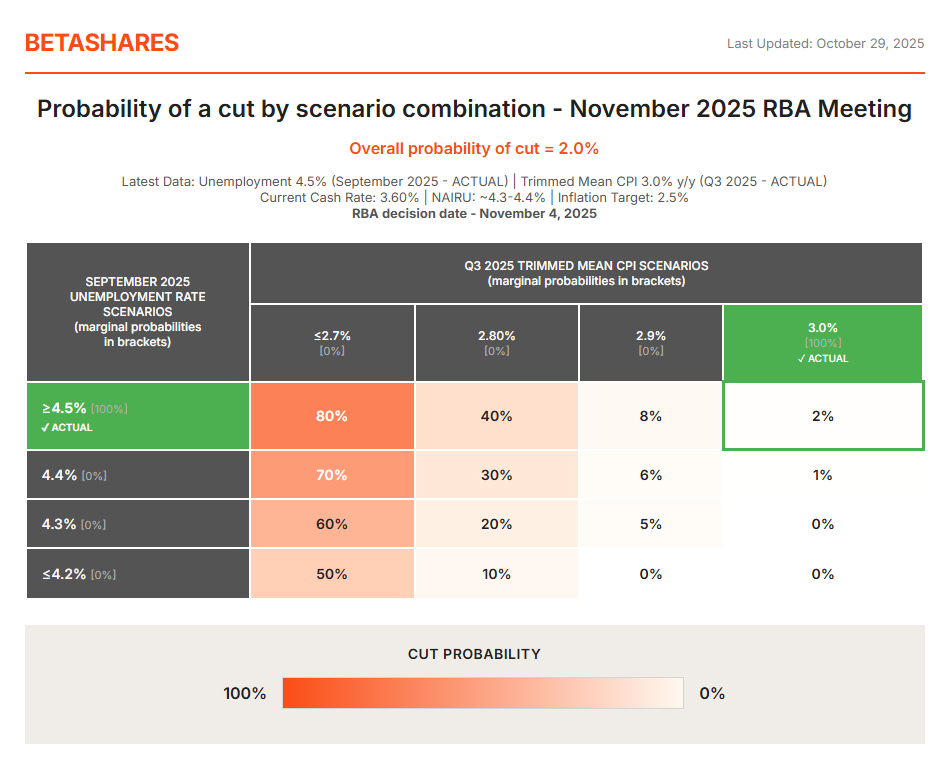How the RBA (and other central banks) makes decisions
Every six weeks on a Tuesday, the Reserve Bank of Australia (RBA) announces its latest interest rate decision.
As soon as the decision drops, bond yields change, currency rates shift, the share market reacts and mortgages rates move. But how much does the average investor know about what goes into these decisions? Because behind each announcement sits a surprisingly straightforward framework.
That framework can help explain why, post the 30 September 2025 RBA meeting, bond markets reacted negatively even though the central bank held rates steady as widely expected. This was due to the shift in the RBA’s tone on their view of inflation risk, which tilted the scales of the framework. As such, post meeting, the consensus expectation for interest rate cuts was reduced from two to one and the timing of the next cut was also pushed back.
Why? Because the relative importance of the two things the RBA looks at have changed – and so has the market expectations on how the RBA would react to data. Understanding what drives these decisions, and how to interpret the key data, can give investors an edge in positioning portfolios ahead of the crowd.
The RBA’s dual mandate
Every central bank has a mandate and some, like the RBA, have two. The two parts of this dual mandate are:
- Price stability: Maintaining low and stable inflation with a target of 2-3% inflation on average over time. The midpoint of 2.5% serves as the medium-term goal. The ‘trimmed mean’ measure is the RBA’s preferred metric for gauging its progress on inflation, because it removes the most extreme price movements of items such as oil and food.
- Full employment: Maximising sustainable employment through a low unemployment rate and a high participation rate. Note, this does not mean zero unemployment, but rather the level where everyone who wants a job can find one without causing wages and prices to accelerate (or, as economists call it, the Non-Accelerating Inflation Rate of Unemployment – NAIRU).
Another example of a central bank that shares this dual mandate is the US Federal Reserve; while most major economy central banks have informal dual mandates, such as the European Central Bank, the Bank of England and the Bank of Canada.
A simple way to visualise a rate decision
After understanding the RBA’s dual mandate, the natural question is how do these two factors actually interact to drive rate decisions?
The most important thing to note is that the RBA never looks at each number in isolation. It’s constantly weighing trade-offs. If inflation is tracking perfectly but unemployment is rising, what does it do? If unemployment is low but inflation is stubbornly high, which takes priority? The latter is the problem that the RBA (and the Fed) have been dealing with consistently in the wake of the COVID-19 pandemic.
To help make sense of all this, let’s look at this sample probability matrix. Note, this matrix is based on my views at a particular time and is included here as a way of visualising the RBA’s framework.
RBA probability matrix

Source: Betashares. For illustrative purposes only.
Think of it like a grid:
- Across the top: Four possible outcomes for inflation (trimmed mean CPI) from lower to higher.
- Down the side: Four possible outcomes for unemployment, from lower to higher.
- Inside each box: My assessment of how likely the RBA would be to cut rates if that particular combination occurred. The darker the shading, the higher the likelihood of a cut.
The marginal probabilities of each scenario (unemployment rate and CPI) occurring are shown in the square brackets and is subjective to my personal views on the likelihood of each scenario occurring.
The matrix shows 16 possible combinations of where inflation and unemployment could land. Then, for each combination of scenario pairs, I assigned a subjective view on the probability of an RBA cut should these scenarios occur. The overall chance of a rate cut is calculated by adding up all the possible outcomes, each weighted by how likely it is to happen and then is expressed as a percentage.
Three points to note:
- These scenario ranges are informed by the latest quarterly data releases, combined with recent monthly data releases and trends.
- This framework is being used to assess the next RBA move rather than longer-term considerations.
- The probabilities shown are my views based on my subjective assessment.
Understanding the probability framework
The key is understanding the RBA’s concept of the ‘neutral rate’: the interest rate level that keeps the economy running at a steady pace when both employment and inflation are where they should be. This is not to be confused with the above explanation for the NAIRU, as NAIRU refers to the relationship between unemployment and inflation while the neutral rate applies to the cost of money and growth.
Think of it this way: if unemployment sat at the ideal level and inflation hit the 2.5% target, the RBA would set rates at what it believes to be neutral – neither accelerating nor slowing the economy. The challenge is that this neutral rate is not a fixed number that can be looked up. It is not directly observable, and it shifts over time as the economy evolves.
Real life evolution of the matrix
Now, let’s look at how this matrix evolves when real-world data releases are taken into account.
Our starting point is after the 30 September RBA meeting, when Governor Michele Bullock described policy as being “a little bit restrictive”. This means that if unemployment remained at current levels or increased slightly toward NAIRU, and trimmed mean CPI moved toward the 2.5% target, the RBA would cut rates back to neutral.
However, the RBA does not view the risks of inflation and unemployment as balanced. Governor Bullock discussed the need to be “a little bit cautious” about upside inflation surprises – language the market interpreted as hawkish (meaning a central bank may be more inclined to raise interest rates). This signals the RBA is placing greater weight on higher-than-expected inflation than higher-than-expected unemployment. This was the basis for our initial matrix above which had an overall cut probability of 26.2%.
Then, on 16 October 2025, the September unemployment rate of 4.5% was published. The rise in unemployment came as a shock to the market and saw the probability of a cut greatly increase to 77%, given the deterioration of the jobs market. This is how the matrix evolved with this news in mind:
RBA probability matrix – Post-September labour force report update

Then, following the labour force report and just before the Q3 inflation report was released: RBA Governor Michele Bullock stated at a dinner event on 27 October 2025 that the board which decides monetary policy would be retaining a “cautious” policy stance as a single month employment data can be quite volatile and that the state of the current economy is “a very satisfying outcome”. These remarks caused a significant drop in the market’s expectations for a quarter-point cut and thus, led to a second update to the matrix. After this speech, the overall cut probability dropped back down to 36%.
RBA probability matrix – Post-Bullock address update

Source: Betashares. For illustrative purposes only.
The last part of this story is the Q3 2025 CPI data, which was published on 29 October 2025. A trimmed mean CPI of 3.0% year on year was significantly higher than the expectations of economists, markets and the RBA itself. With this news, the scorching CPI data burned any real chances of an RBA cut at the next meeting. Our final matrix shows that the probability of a cut is now just 2%:
RBA probability matrix – Post-Q3 CPI update

Source: Betashares. For illustrative purposes only.
Monetary policy is always evolving
The probability matrix shows how the RBA balances inflation and employment data to make rate decisions. As we saw from September to October 2025, this isn’t static.
For investors, understanding this framework means an investor can understand why their portfolio may react a certain way to data releases and central bank communications. The data will keep changing and the RBA’s view will keep evolving, but the underlying approach stays the same: two key numbers tend to shape every interest rate decision, and with it, the performance of an investor’s portfolio.
This piece was written by Jing Jia, Portfolio Manager at Betashares. The original piece was published on 29 October 2025, before the Q3 CPI print was released. This version of the piece reflects how the matrix changed after the Q3 CPI report.

